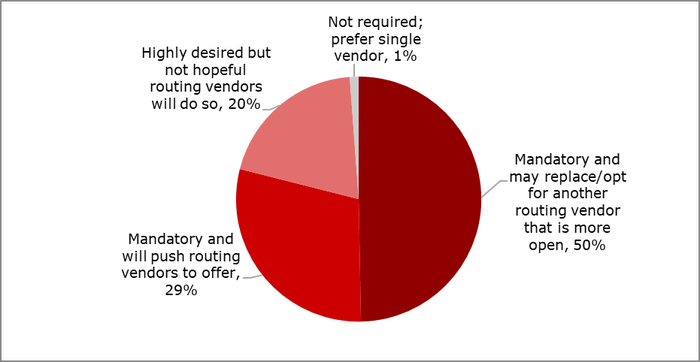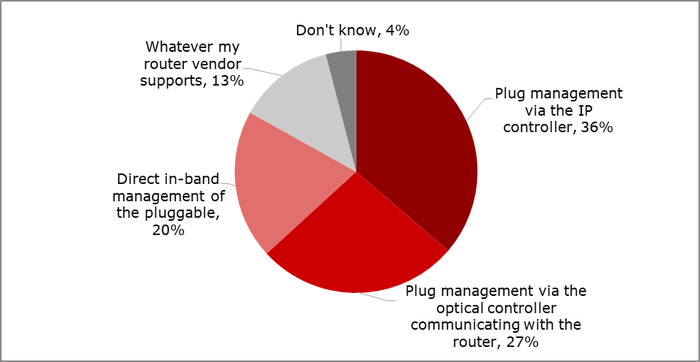IPoDWDM: Plugging into compatibility issues
Key findings from Heavy Reading's 2023 Coherent Optics Market Leadership Program show that IPoDWDM has secured a place within telecom network architectures, but the industry must still overcome operational challenges.

Naysayers argued that the coherent era of pluggable optics on routers — or IP over DWDM (IPoDWDM) — would be no different from the past attempts at the architecture that failed to materialize. But coherent pluggable innovation is flourishing, and early adopters in telecom are rolling out networks with strongly positive results. As technologies continue to mature, the topic of module management has come to the fore.
Heavy Reading launched the first Coherent Optics Market Leadership Program in 2021 to investigate emerging opportunities and challenges in coherent optics, spurred by the advent of 400ZR optics. The most recent 2023 project was based on a global network operator survey conducted in November that attracted 88 qualified responses.
This is the first installment of three blogs highlighting the key findings from the 2023 survey project. It focuses on systems-level control and management in multi-layer networks and plug-to-host compatibility.
IPoDWDM challenges
IPoDWDM is a radical departure from the traditional transport architecture, so it is not surprising that significant barriers exist. Notably, the top challenges are consistent with 2022 survey results, though there is some jockeying among the top challenges. Module-to-module interoperability has long been a key topic in coherent pluggable optics, but over the past year, the industry has increasingly focused on compatibility between coherent modules and the host router.
Over the past decade, we have seen great progress in defining open, multi-vendor transport network architectures, and selecting different optical and IP vendors with separate optical and IP layers is the industry norm today. Operators do not want to go backward and be locked to their router vendor when moving to IPoDWDM. They expect to have control over the choice of router and optical vendors.
For this reason, plug-to-host compatibility has quickly become a more pressing issue than plug-to-plug interoperability. As such, insufficient support for third-party pluggables is now the number one barrier to IPoDWDM adoption.
What are the main barriers to DWDM pluggables adoption in routing/switching products (IPoDWDM)? (Top five)

(Source: Heavy Reading, 2023)
The importance of third-party pluggables
Beyond hardware support, plug-to-host compatibility requires extensive management integration between the host router and the coherent module. The simplest solution to this challenge is to buy the router and the optics from the same vendor. However, as noted above, operators do not view this as a good strategic move. And additional survey data shows just how crucial multi-vendor optics support is — despite the challenges presented. More than three-quarters of operators surveyed believe that third-party optics support is mandatory, and half said that they may even swap router vendors over a lack of third-party optics support.
Meanwhile, an additional 20% of respondents highly prefer third-party optics support but are not hopeful that router suppliers will comply. Just 1% of survey respondents expect to implement a single vendor IPoDWDM architecture.
What is your expectation of router vendors offering support for third-party vendor optics?

(Source: Heavy Reading, 2023)
Focusing on pluggable management
As noted, host-to-pluggable compatibility requires tight integration at the management layer, but operator preferences are widely mixed on how to manage coherent pluggable optics in routers. In a perfect world, management would be via the overall system management platform — in this case, the IP controller. But nearly half of the survey group show a clear preference for something other than the IP controller. 27% prefer to manage pluggables via optical controllers that then communicate with the routers, and another 20% favor direct in-band management of optics.
The results reflect the fact that routers today lack essential levels of control, visibility and troubleshooting to manage coherent pluggables on their own. Thus, the optical layer must play a role. The lack of cohesion is not surprising given the early state of the industry, but we need a solution for the manageability issue. Due to the multi-vendor nature of the issue, industry standardization will be critical. Several industry groups are active in these areas, covering the IP layer and the optical layer — and multi-layer coordination across the two. Work is ongoing within the Telecom Infra Project (TIP), the Internet Engineering Task Force (IETF) and the Optical Internetworking Forum (OIF).
What is your preferred approach when managing coherent plugs in routers?

(Source: Heavy Reading, 2023)
Spurred by coherent pluggable optics, IPoDWDM has finally secured a place within telecom network architectures, and its role will only expand over time. Now, the industry must focus on overcoming the operational challenges associated with this new paradigm in a multi-vendor world.
For more information on this topic and the Heavy Reading survey, check out this archived Light Reading webinar: Coherent Pluggable Optics: The Next Frontier.
This blog is sponsored by Ciena.
About the Author(s)
You May Also Like













